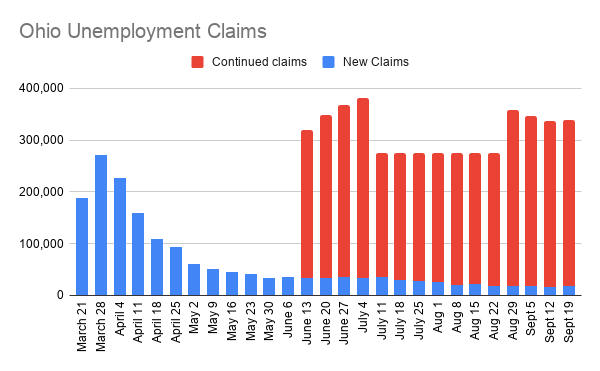Ohio Unemployment Claims Tick Up Slightly to 17K
YOUNGSTOWN, Ohio – The Ohio Department of Job and Family Services reports 17,435 initial jobless claims filed last week, as well as 321,057 continued claims.
Both figures are up about 1,000 from the week ended Sept. 12.
Over the past 27 weeks, since the pandemic began affecting Ohio, the state has disbursed $6.6 billion in unemployment compensation to 809,000 Ohioans, as well as $6 billion in pandemic unemployment assistance to 569,000 claimants.
In Pennsylvania, the state’s Department of Labor reports 21,747 new claims filed in the week ended Sept. 12. Since March 15, the state has received 2,122,486 unemployment claims.
The state has paid out $4.7 billion in unemployment compensation, as well as $4.5 billion in pandemic unemployment assistance.
Nationwide, 870,000 people filed for unemployment, according to the U.S. Department of Labor.

The figure coincides with evidence that some newly laid-off Americans are facing delays in receiving unemployment benefits as state agencies intensify efforts to combat fraudulent applications and clear their pipelines of a backlog of jobless claims.
California has said it will stop processing new applications for two weeks as it seeks to reduce backlogs and prevent fraudulent claims. Pennsylvania has found that up to 10,000 inmates are improperly receiving aid.
The Labor Department said Thursday that the number of people who are continuing to receive unemployment benefits declined to 12.6 million. The steady decline in that figure over the past several months reflects that some of the unemployed are being re-hired. Yet it also indicates that others have exhausted their regular jobless aid, which last six months in most states.
In addition to those receiving aid on state programs, about 105,000 others were added to an extended jobless-benefits program that provides 13 additional weeks of aid. This program, established in the economic relief package that Congress passed earlier this year, is now paying benefits to 1.6 million people.
Applications for jobless aid soared in the spring after the viral outbreak suddenly shut down businesses across the country, slashed tens of millions of jobs and triggered a deep recession. Since then, as states have slowly reopened their economies, about half the jobs that were initially lost have been recovered.
Yet job growth has been slowing. In most sectors of the economy, employers appear reluctant to hire new workers in the face of deep uncertainty about the course of the virus.
The growing concerns about fraudulent applications for unemployment benefits have focused mainly on a new program, Pandemic Unemployment Assistance. This program made self-employed people, gig workers and contractors eligible for jobless aid for the first time.
Though roughly 14 million people are classified as receiving aid under that program, economists increasingly regard that figure as unreliable and likely inflated by both fraudulent applications and inaccurate counts. The number of people receiving benefits under the PUA program is probably overstated by several million, economists say.
Thursday’s report from the government comes against the backdrop of an economy that has been recovering fitfully from a catastrophic recession. Some economic barometers, like housing, retail purchases and auto sales, have managed to produce solid gains. But with unemployment elevated at 8.4% and a key federal jobless benefit having expired, the economy’s gains are believed to be slowing.
Most economists say it will be hard for the job market or the economy to sustain any recovery unless Congress enacts another rescue aid package for struggling individuals, businesses and states. Ultimately, an effective vaccine will likely be needed for the economy to fully regain its health.
In the meantime, California and other states are trying to manage their beleaguered jobless benefits programs.
Sharon Hilliard, director of California’s Employment Development Department, said her agency would stop accepting applications for aid for two weeks while it adopts reforms recommended by a state task force. The department will try to clear a backlog of nearly 600,000 first-time applications and review about 1 million people who have received unemployment benefits but whose cases have come under scrutiny.
These people include gig workers and contractors who have more difficulty verifying their income than do traditional employees whose tax forms are on file with the state.
Copyright 2024 The Business Journal, Youngstown, Ohio.



